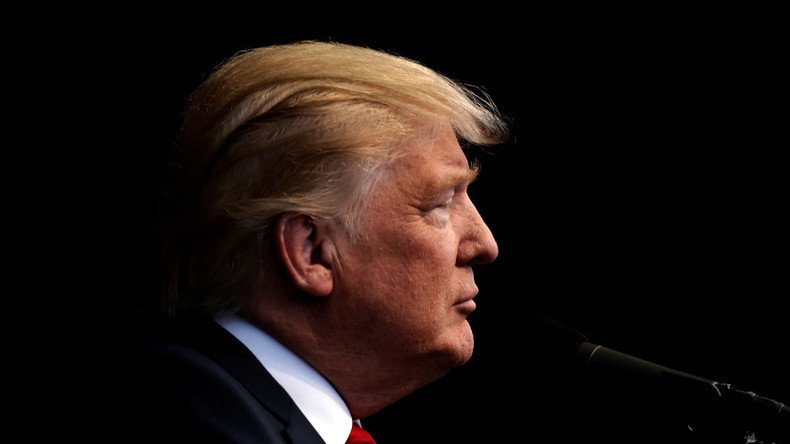Could the Republican Party oust Trump as their nominee?

Revelations of Donald Trump’s taped sexist remarks have prompted heated debate among Republicans on how to remove their controversial billionaire candidate from the presidential ballot just one month before election day.
Senior Republican Party officials have reportedly called an emergency meeting to discuss their options for potentially ousting their own nominee.
Top Republicans urge #Trump to quit race amid tape scandal https://t.co/V8tZeX1g5hpic.twitter.com/Z1iGBauqw1
— RT America (@RT_America) October 9, 2016
So what options does the Republican Party have this late in the game? RT takes a look at some of the possibilities.
A new nominee?
Rule 9 of the Republican Party’s regulations concerns ‘Filling Vacancies in Nominations’. It states that the Republican National Committee (RNC) can fill any vacancies which occur “by reason of death, declination or otherwise”.
Though the word “otherwise” is vague, it opens the door for Republicans to invoke Rule 12 to amend the reasons for filing a nomination vacancy. However, this facility could take 40 days to complete, and there’s not enough time for that.
Don't know that it'd be worth getting your hopes up over though.
— Josh Putnam (@FHQ) October 8, 2016
Here's a link to Rule 9(a): https://t.co/tiggOuYhK2
So, is it a case of too little too late? Not necessarily, according to Politico. Under Rule 7 (a) and “Robert’s Rules of Order”, the RNC apparently has the power to suspend the time restrictions of Rule 12 if it has a two-thirds majority vote, meaning in theory Trump could be replaced as the presidential nominee much sooner.
"@eericmyers: @realDonaldTrump "Republican leadership" should have only one job: Help elect the nominee we voted for, Donald J. Trump."
— Donald J. Trump (@realDonaldTrump) October 9, 2016
Names on the ballot
One of the major stumbling blocks for putting forth a new GOP candidate is the deadline for adding a name to the ballot. A Ballotpedia list shows they vary wildly from state to state - but, in around 40 states, the deadlines have already passed.
READ MORE: Trump-Clinton, reloaded: Candidates prep for high-stakes 2nd presidential debate
It is incredibly difficult to see how a new candidate could be added to the ballot now unless the courts decide to discard the state deadlines - something that has been done in a Senate election in the past - but never applied to a presidential candidate.
People who really want to cast their vote for someone not named on the ballot can actually go ahead and write that person’s name in themselves. However, write-in candidates are still required to apply for their votes to be tallied in 34 states, and many of these deadlines have passed.
A further nine states do not permit write-in candidates at all. It’s very difficult to see how a write-in, even an incredibly high profile one backed by the Republican Party, could make a serious presidential push come 8 November.
Even if the GOP successfully removed Trump as the Republican nominee, it’s likely his name would still remain on the ballot - creating chaos, confusion and no doubt a flurry of legal challenges.
The media and establishment want me out of the race so badly - I WILL NEVER DROP OUT OF THE RACE, WILL NEVER LET MY SUPPORTERS DOWN! #MAGA
— Donald J. Trump (@realDonaldTrump) October 8, 2016
Those Republicans scrambling to dump Trump could have their prayers answered by state laws on electors in the Electoral College, who meet in December to formally elect the president. Under the Constitution, voters do not vote directly for presidential candidates - it’s the Electoral College, representing individual states, that chooses the next president. And states have different laws on how this binds electors.
Tremendous support (except for some Republican "leadership"). Thank you.
— Donald J. Trump (@realDonaldTrump) October 9, 2016
Even in the unlikely event of Trump’s name being removed from the ballot, the electors may still be bound to vote for him - which could result in legal action with “little, if any, precedents to guide the litigants and judges” on how members of the Electoral College should behave, notes Ian Millhiser, a Constitutional law expert at the Center for American Progress.
There is something of a precedent, however, when it comes to swapping vice-presidential candidates, which happened in 1972 and 1980. Crucially though, no major party presidential candidate has ever been replaced after securing the nomination.
Voting has actually started
Overseas voting is already underway.
To answer question I've been getting--No, Trump cannot drop out & be replaced on ballot. UOCAVA ballots are out, early voting has begun.
— Marc E. Elias (@marceelias) October 8, 2016
Around 8 million Americans, not including military personnel, are estimated to be currently living outside of the US. It’s not clear how many of these are registered to vote for the upcoming presidential election, however if previous elections are an indication, the figure will be relatively low.
Less than 7 percent of eligible overseas voters cast their ballots in the 2008 election, which tallied fewer than 180,000 ballots.
Could the presidential election be delayed?
While in theory it may be possible to postpone an election, it is - unsurprisingly - a very complicated issue.
The US Congress has the power to postpone the election date under Article II Section 1 of the Constitution, but each state has the authority to make its own decision.
Another issue with Congress postponing the election lies with the Constitution’s 20th Amendment which requires that congressional terms expire January 3 and presidential terms on January 20. So if the elections happened after January 3, Congress could have effectively voted themselves out of office.












